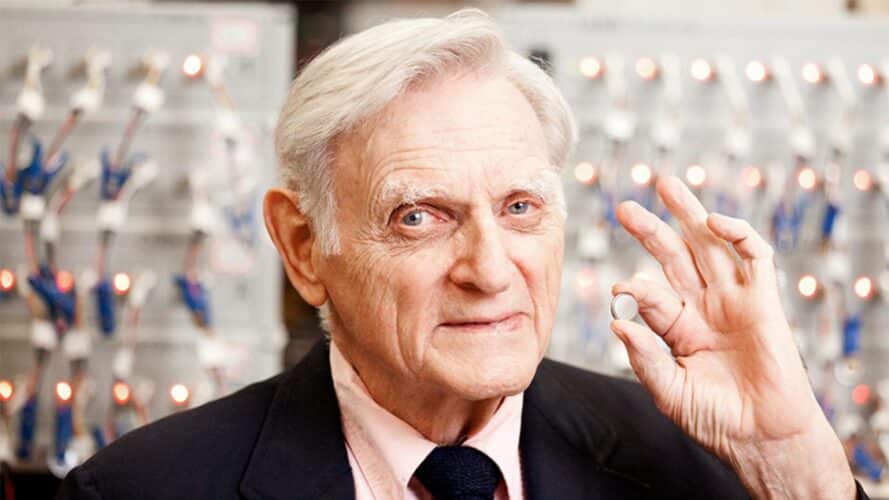The Life and Achievements of John B. Goodenough

John B. Goodenough (25 July 1922 – 25 June 2023) was an American materials scientist and a solid-state physicist. John B. Goodenough was awarded the Nobel Prize in Chemistry in 2019.
Early Life And Education
John B. Goodenough, an esteemed American materials scientist and Nobel laureate, was born on July 25, 1922, in Jena, Germany, to American parents. His father, Erwin Ramsdell Goodenough, was a notable professor of religious history at Yale University, and his mother was Helen Miriam (Lewis) Goodenough. Growing up in an academic environment, John was surrounded by intellectual pursuits from an early age. His brother, Ward, became a professor of anthropology, and he also had two half-siblings who pursued academic careers.
Goodenough’s educational journey began with a bachelor’s degree in mathematics from Yale University in 1943, during which time he also served as a meteorologist in the U.S. Army Air Forces in World War II. After the war, he furthered his studies in physics at the University of Chicago, where he earned a master’s degree in 1951 and a Ph.D. in 1952. His doctoral thesis focused on a theory of the deviation from close packing in hexagonal metal crystals, under the guidance of Clarence Zener. Goodenough’s early life laid a strong foundation for his later groundbreaking work in developing the lithium-ion battery, which revolutionized energy storage and power generation. His contributions to science have been recognized with numerous prestigious awards, including the Nobel Prize in Chemistry in 2019, making him the oldest recipient of the prize at the age of 97.
Career And Achievements
John B. Goodenough’s academic journey began with a bachelor’s degree from Yale University, followed by a master’s and Ph.D. from the University of Chicago. His early work as a U.S. military meteorologist during World War II set the stage for a distinguished career in material science and solid-state physics. Goodenough’s seminal work at MIT’s Lincoln Laboratory led to the development of random-access memory (RAM) for computers, but it was his invention of the lithium-ion battery that revolutionized portable electronics and electric vehicles. His contributions to the field earned him the Japan Prize in 2001, the Enrico Fermi Award in 2009, and the National Medal of Science in 2011. In 2019, at the age of 97, he was awarded the Nobel Prize in Chemistry, becoming the oldest Nobel laureate in history. His legacy is further honored through the John B. Goodenough Award in materials science, reflecting the profound impact of his work on modern society.
Notable Events And Milestones
John B. Goodenough’s life and legacy are marked by a series of significant events and milestones that have had a profound impact on technology and society. His service as a U.S. military meteorologist during World War II was followed by a distinguished academic career, earning a Ph.D. in physics from the University of Chicago and contributing to the development of RAM at MIT’s Lincoln Laboratory.
Goodenough’s move to the University of Oxford as the head of the Inorganic Chemistry Laboratory marked a pivotal point in his career, where he developed the lithium cobalt oxide cathode, a critical component of lithium-ion batteries. This invention not only revolutionized portable electronics, enabling the proliferation of devices like smartphones and laptops, but also played a crucial role in the transition to clean energy, supporting the adoption of electric vehicles and renewable energy sources.
Throughout his career, Goodenough received numerous accolades, including the Japan Prize, the Enrico Fermi Award, the National Medal of Science, and the IEEE Medal for Environmental and Safety Technologies. His work earned him the Copley Medal and, at the age of 97, the Nobel Prize in Chemistry, making him the oldest Nobel laureate in history. The John B. Goodenough Award in materials science is named in his honor, reflecting his lasting influence on the field.
Goodenough’s contributions extend beyond the realm of science and technology. His pioneering efforts in battery development have had far-reaching implications for global culture and society, facilitating a shift towards more sustainable energy practices and reducing reliance on fossil fuels. His work has enabled advancements in medical devices, space exploration, and communication technologies, fundamentally altering the way we interact with the world and with each other.
The legacy of John B. Goodenough is etched in history, not only through his groundbreaking scientific contributions but also through the societal transformations they have spurred. His vision and perseverance have paved the way for future innovations and continue to inspire scientists and engineers around the globe. As we reflect on his life, we recognize the indelible mark he has left on our world, reshaping our understanding of energy, materials, and the very fabric of modern life. His story is a testament to the power of curiosity, dedication, and the relentless pursuit of knowledge.
Awards And Honors
- Japan Prize (2001)
- Enrico Fermi Award (2009)
- National Medal of Science (2011)
- IEEE Medal for Environmental and Safety Technologies (2012)
- Charles Stark Draper Prize (2014)
- Welch Award (2017)
- Copley Medal (2019)
- Nobel Prize in Chemistry (2019)
Additional Resources
Books:
- “Magnetism and the Chemical Bond” (1963)
- “Solid Oxide Fuel Cell Technology: Principles, Performance and Operations” (2009, with Kevin Huang)
- Autobiography “Witness to Grace” (2008).
Documentaries:
- Nobel Lecture: John B. Goodenough, Nobel Prize in Chemistry 2019.
- Official interview by the Nobel Prize organization.
- “John Goodenough – Changing the World” available on YouTube.
Museums:
- Nobel Prize Museum in Stockholm, where Goodenough’s work is featured.
Please note that the availability of these resources can vary, and it might be beneficial to check their current status or any updated editions.
Observer Voice is the one stop site for National, International news, Sports, Editor’s Choice, Art/culture contents, Quotes and much more. We also cover historical contents. Historical contents includes World History, Indian History, and what happened today. The website also covers Entertainment across the India and World.

